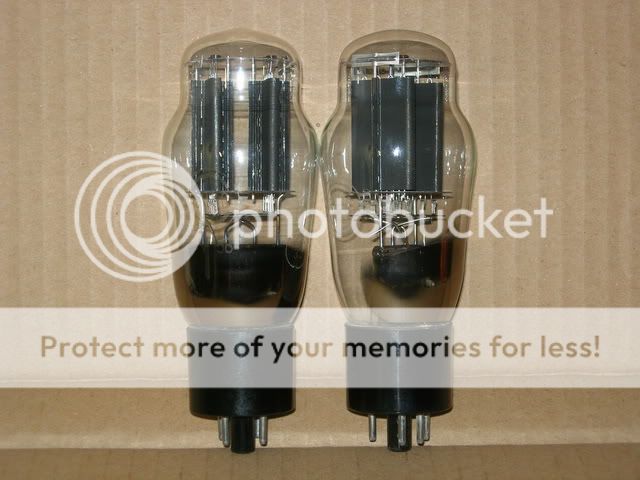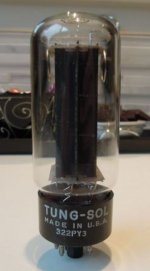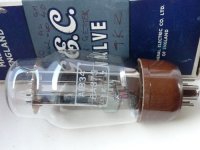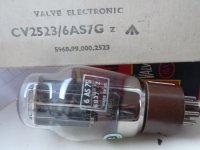If you can, only listen to the tubes as they must sound very good to you.Ask your friends if they have the U52 tubes to listen to.
Peter
Peter
Last edited:
If you can, only listen to the tubes as they must sound very good to you.Ask your friends if they have the U52 tubes to listen to.
Peter
Peter, can I please listen to your NOS GEC U52. I only need it for a year or two,
.... Im getting Morten's Russian rectifiers:

,,,,Morten did you get the older 1950's/1960's black plate type as reviewed here?
Eventually Peter and I might be able to compare the U52 vs the Russian.
A data sheet for the U52 states its a "half wave rectifier" while the 5U4G is a "full wave". I wonder what that means and if it would make any difference to the sound?

,,,,Morten did you get the older 1950's/1960's black plate type as reviewed here?
Eventually Peter and I might be able to compare the U52 vs the Russian.
A data sheet for the U52 states its a "half wave rectifier" while the 5U4G is a "full wave". I wonder what that means and if it would make any difference to the sound?
Last edited:
....
,,,,Morten did you get the older 1950's/1960's black plate type as reviewed here?
To be honest: I don't know...
These rectifiers should be considered good NOS standard types, and extremely good value. Don't buy them as the best of the best like the ones Peter is talking about.
Hugh and Morten, the Russian 5U4 rectifiers pictured, sound very average compared to the GEC U52 tube. The U52 tube was extremely quiet and extremely musical. I did not believe it until I heard it myself. There must be other musical rectifier tubes. If anyone has tried the U52 and other 5U4 equivalent tubes, please speak up. The GZ37 and GZ33 tubes are interesting as promising alternates.
Peter
Peter
Hugh and Morten, the Russian 5U4 rectifiers pictured, sound very average compared to the GEC U52 tube. The U52 tube was extremely quiet and extremely musical. I did not believe it until I heard it myself. There must be other musical rectifier tubes. If anyone has tried the U52 and other 5U4 equivalent tubes, please speak up. The GZ37 and GZ33 tubes are interesting as promising alternates.
Peter
I wonder how the U52 will sound with the Coleman Regulators and 2A3 tubes?
Hugh and Morten, the Russian 5U4 rectifiers pictured, sound very average compared to the GEC U52 tube. The U52 tube was extremely quiet and extremely musical. Peter
Yes, I got the message (I also got it the first, and the second time you mentioned it) 😀 From your enhusiasm about them, they must be really good..!
The GEC labelled U52 brown base, black plate, 'D' Getter with manufacturers 'KB/Z' rectifiers has a fast dynamic sound which Steve Garland who has heard my Tram2 said this tube would be a very good combination in my system. The Osram labelled U52 with brown base, black plate, 'D' Getter without the 'KB/Z' labeled have a lush, full bodied and slower sound. It all depends on your taste of how you like your music to sound. I will ask him on his pick of non U52 tubes that would suit the tram2 pre-amp. More later.
Peter
Peter
I spoke to Steve again and he said the Creme De La Creme of U52 tubes are the NOS 'D' getter Genelex Lion U52 tubes. If you can not afford these tubes or the GEC U52 variants, go for the Tung-sol 5U4G with top getter. Even Tung-sol 5U4GB tubes have a punchy bass according to Re: Genalex Gold Lion U52 vs. GEC U52? - Robert H. - Tubes Asylum
All the best
Peter
All the best
Peter
I made a small tweak recently...
I don't know about your Tram II's but mine is a pain when it comes to adjusting the 120V anode voltage on the CCS modules. I get it set to around 120V dc, all is good, but then after some weeks the anode voltage start drifting. This is heard as noise when the voltage drops below a certain point. Last time I opened it to re-calibrate the anode voltage it was down at around 90V dc in the left channel. (I should mention, than when adjusting the anode voltage I always let it stabilize for at least half an hour so I'm sure it's stable).
The problem is, that just a change of a few ohms on the trimmer will mean a big change in anode voltage, and it seems that these trimmers can drift a bit over time...
I have now installed resistors instead of the trimmers. In one channel I have an 82 ohm resistor, in the other channel I have 82 ohm // 2k2. The anode voltage appears to be rock solid (at least for now) and there is ZERO noise through the speakers..!!!! With the anode voltage being totally stable at the correct 120 - 125V and the Rod Coleman DHT regulators, the Tram II is now one of the quietest tube preamps I have experienced... Impressive for a DHT running 2A3 tubes 😎
The downside is that it will of course be more work when changing tubes, because fixed resistors needs to be replaced, but since I'm done tube-rolling on the triodes, this is not a problem for me...
I don't know about your Tram II's but mine is a pain when it comes to adjusting the 120V anode voltage on the CCS modules. I get it set to around 120V dc, all is good, but then after some weeks the anode voltage start drifting. This is heard as noise when the voltage drops below a certain point. Last time I opened it to re-calibrate the anode voltage it was down at around 90V dc in the left channel. (I should mention, than when adjusting the anode voltage I always let it stabilize for at least half an hour so I'm sure it's stable).
The problem is, that just a change of a few ohms on the trimmer will mean a big change in anode voltage, and it seems that these trimmers can drift a bit over time...
I have now installed resistors instead of the trimmers. In one channel I have an 82 ohm resistor, in the other channel I have 82 ohm // 2k2. The anode voltage appears to be rock solid (at least for now) and there is ZERO noise through the speakers..!!!! With the anode voltage being totally stable at the correct 120 - 125V and the Rod Coleman DHT regulators, the Tram II is now one of the quietest tube preamps I have experienced... Impressive for a DHT running 2A3 tubes 😎
The downside is that it will of course be more work when changing tubes, because fixed resistors needs to be replaced, but since I'm done tube-rolling on the triodes, this is not a problem for me...
Morten, there must be a better/stable Trim pot than the one supplied by DIYHIFI Supply. RS Components or Farnell Components. I will have to measure my circuit for appropriate resistors.
thanks for your tweak.
Peter
thanks for your tweak.
Peter
The trimmer is a good quality multiturn trimmer, so the ones in the preamp are as good as they get...
The problem is, that the whole resistor is in the trimmer, so even a microscopic change means a big voltage change on the anode. What can be done is a small tweak of the circuit where (for instance) a 75 ohm reistor is used in series with a 10 ohm multiturn trimmer. With this set-up just a little of the resistor is in the trimmer. It would be possible to adjust, the adjustment would be much easier because each turn on the trimmer is much less change in resistance. Any drift would also be much less drift in resistance meaning that the anode voltage is less likely to drop out of ''the zone''.
This little mod means replacing the existing multiturn trimmers with similar ones, just 10 ohm and then making a small mod, cutting a track on the small circuit board to get the 75 ohm reistor in series.
For now I'm happy with the fixed resistor solution, maybe some day I will make the modification mentioned here.
The problem is, that the whole resistor is in the trimmer, so even a microscopic change means a big voltage change on the anode. What can be done is a small tweak of the circuit where (for instance) a 75 ohm reistor is used in series with a 10 ohm multiturn trimmer. With this set-up just a little of the resistor is in the trimmer. It would be possible to adjust, the adjustment would be much easier because each turn on the trimmer is much less change in resistance. Any drift would also be much less drift in resistance meaning that the anode voltage is less likely to drop out of ''the zone''.
This little mod means replacing the existing multiturn trimmers with similar ones, just 10 ohm and then making a small mod, cutting a track on the small circuit board to get the 75 ohm reistor in series.
For now I'm happy with the fixed resistor solution, maybe some day I will make the modification mentioned here.
...This little mod means replacing the existing multiturn trimmers with similar ones, just 10 ohm and then making a small mod, cutting a track on the small circuit board to get the 75 ohm reistor in series...
That's brilliant.
This might be a silly question but do you think a 10ohn trimmer will have enough range to change from 45's to 2A3's OK?
Is it possible to mount the trimmer's so the adjustment can be done from the outside without needing to unplug the Tram2?
Cheers
Don't know if it's enough range for 45's, but since I don't use them I don't need range for them... The point is, that the smaller part of the total resistance value is in the trimmer, the easier the adjustment will be, and the less it's likely to drift. So if someone needs bigger range then just use slightly bigger trimmer and slightly smaller fixed resitor in series...
If you install multiturn trimmers facing up, drill some small holes in the top of the chassis, and install a voltmeter measuring the anode voltage then you can adjust without opening the chassis... But what is the point? The small mod is to aviod drift and to avoid having to make adjustments...
If you wan't it for easy tube rolling you can of course install this.
If you install multiturn trimmers facing up, drill some small holes in the top of the chassis, and install a voltmeter measuring the anode voltage then you can adjust without opening the chassis... But what is the point? The small mod is to aviod drift and to avoid having to make adjustments...
If you wan't it for easy tube rolling you can of course install this.
Ive just set up my Tram2 and have a smile on my face. Im just using old National Union 45's and dont have the Coleman regulators in yet but its dead quiet at 150cm from the speakers and sounds great 🙂
There is never noise with the 45 tubes, not with the original DHT regulators, not with the Rod Coleman.
Once again: The biggest benefit of the Rod Coleman regulators is the improvement in sound. The bonus is the lower noise.
Once again: The biggest benefit of the Rod Coleman regulators is the improvement in sound. The bonus is the lower noise.
- Status
- Not open for further replies.
- Home
- DIY HiFi Supply
- DHT OTL Linestage - Tram 2


